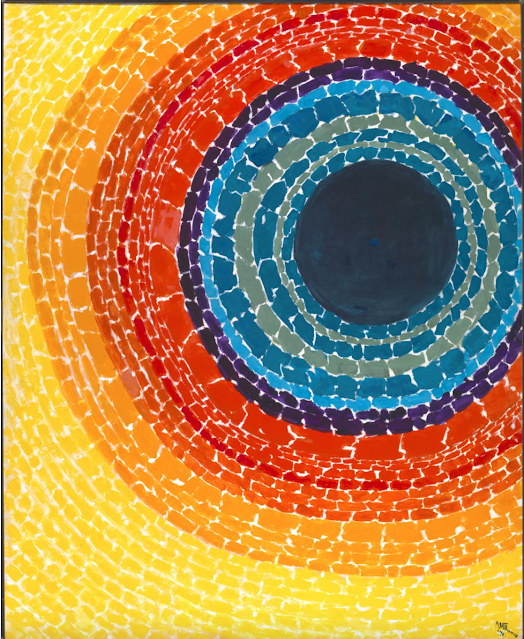Red Rose Sonata, 1972
I discovered Alma Thomas by accident a few years ago in the Metropolitan Museum of Art. I saw this painting Red Rose Sonata in an exhibit surveying post WWII abstract painting and sculpture in the USA from the museum's collections. I was immediately struck by it. It was so different in tone from all the other works in the exhibit, all of them major works of art. This painting begins in sensory pleasure and does not apologize for it in a room full of artists trying to make truly abstract art with no desire to replicate or recall our experiences of the world. The painting is not confrontational, but joyous, and that joy has no ironic inflections. Alma Thomas' painting first and last recalls the pleasure of red roses. She chose (or mixed) that red color very carefully, a color that is very close to the red of red roses. She created an underpainting in a cool viridian green, a complementary color, to set off those reds. The painting remains quite abstract. Nowhere are roses depicted. The painting uses an all over composition as much as Pollock did in his drip paintings.
Perhaps I'm getting sentimental in my tastes as I get older, but I fell in love with this painting as much as I admired so many of the others in the exhibit. I'd never heard of Alma Thomas when I first saw this.
Alma Thomas began to paint professionally very late in life, at age 68. All of these poetic abstract works come from the last years of her life. She spent almost four decades of her life teaching art to junior high students in Washington DC. She didn't exactly appear out of nowhere. She was the first art major to graduate from Howard University in 1924. She began teaching at Shaw Junior High School, a segregated school immediately after graduating from Howard. In 1943, she co-founded the Barnett-Aden Gallery with her former teacher at Howard James W. Herring, among the first galleries devoted to African American artists. She toured Europe in 1958 with students from Tyler University in Philadelphia. She took advanced classes in painting and drawing at American University in 1950.
She did not begin her career as an artist until she retired from Shaw Junior High School in 1960.
By the time she began painting professionally, she was an elderly retiree, but she was hardly an inexperienced hobbyist.
A Fantastic Sunset, 1970
By 1969 - 1970 her work began attracting a lot of serious critical notice. She found herself exhibiting together with the work of Washington's two renowned color field painters Morris Louis and Kenneth Noland and she's sometimes lumped in with them by the textbooks. But her work is so different in form and spirit from theirs. Louis and Noland were in the main stream of official museum-worthy abstract painting at the time. They wanted to further the modern project to collapse the distinction between form and content through reductivism. They wanted to purge their art of all references to the world beyond painting itself. Painting would be its own subject. There's nothing reductivist in Alma Thomas' work, nor is she interested in making paintings about painting. She returned to earlier forms of abstract painting in the 20th century that distilled and interpreted experience instead of purging it from art.
Fiery Sunset, 1973
Alma Thomas created her titles carefully unlike Louis and Noland who were mostly content to number them. In this and in her constant references to nature and landscape she's closest to someone like Helen Frankenthaler who was never shy about landscape references in her work. The painting above is a perfect example taking the colors of a sunset and creating an over-all pattern that recalls the experience of a sunset but does not depict it. Like Mondrian in his painting Pier and Ocean, Alma Thomas distills the experience into a field of suggestive colors and shapes that could be anything from sunset clouds to burning coals without being any of those things.
Her favorite subjects are flowers and the drama of the sky.
Stars and Their Display, 1972
Wind and Crepe Myrtle Concerto, 1973
Fall Begins, 1976
Aquatic Gardens, 1973
The Eclipse, 1970
Alma Thomas was born in Columbus, Georgia into an upper-middle class family in 1891. Her family moved to Washington DC in 1907 fleeing a wave of racist violence in Georgia. Though Washington was a segregated city, it had more opportunities for African Americans than most of the rest of the South did. Her family bought a house in the Logan Circle neighborhood of Washington. Alma Thomas lived in that house for the rest of her life until she died in 1978.









No comments:
Post a Comment